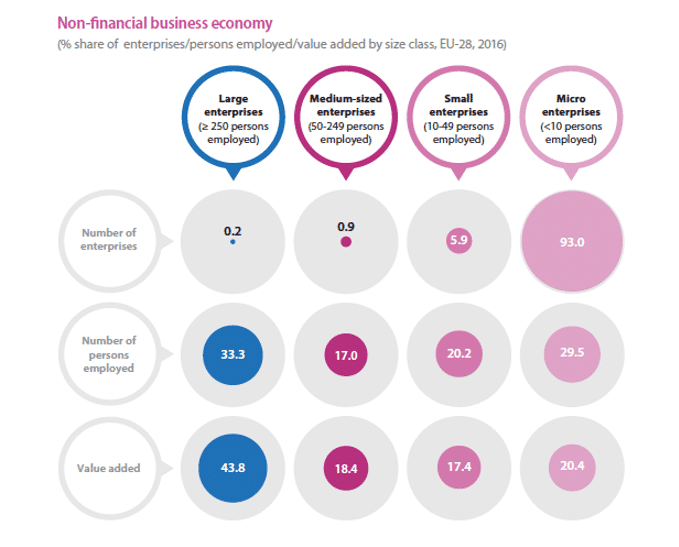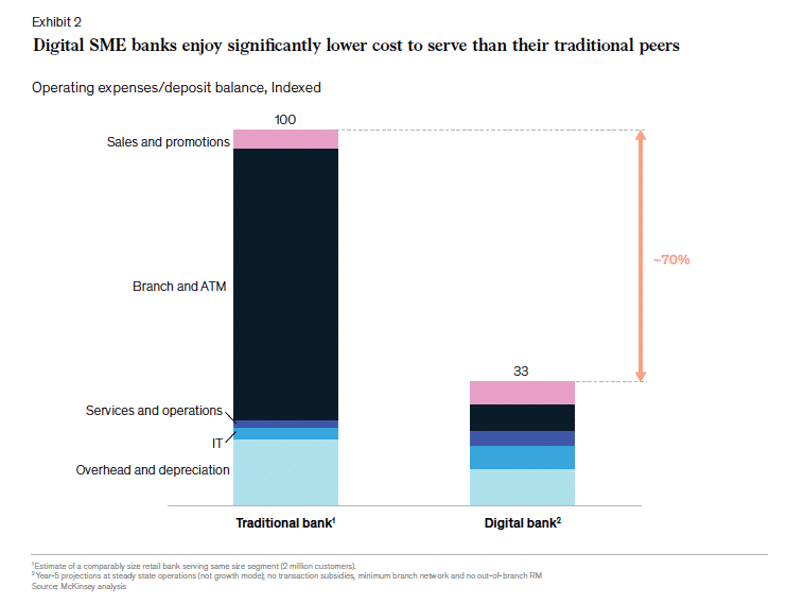
By Kyla Reed - April 17, 2024
Vibrant Credit Union: Breaking Industry Barriers with Embedded Lending
Growing competition is forcing banks and credit unions to rethink their revenue strategies. Read how one credit union used embedded
But how is it that SMEs, both the backbone of so many economies and massive revenue generators for financial services, report being chronically underserved?
And what can banks do to keep and win SME customers in the face of growing competition?
We’ve taken a look at how we got here and the steps banks should take now to make sure they’re fit for tomorrow.
AN ECONOMIC ENGINE…
While it’s a bit of a cliché to describe SMEs as an economic engine, a quick look at the stats proves why they’re worthy of the title.
The most recent data shows there are 24.7 million SMEs in the EU(1) : they make up over 99% of the businesses in the region, provide jobs for 66% of the working population and outstrip large enterprises when it comes to adding value to the economy. (2)

Of course, SMEs are an important source of business for financial services players too. Each year, they generate $850 billion globally in revenue for banks. That accounts for 20% of worldwide banking revenues today, and the future looks promising: the revenue pool is expected to grow by about 7% annually over the next 7 years.(3)
So, if SMEs are both important to the broader economy and a large and growing segment for banks, you wouldn’t expect them to report being underserved. Yet that’s exactly what’s happening.
… AND AN UNDERSERVED MIDDLE
SMEs often say the products and services offered by banks don’t meet their expectations or needs.
Take the case of getting a loan. SMEs typically need to access finance quickly and seamlessly. Yet the average “time to decision” in traditional banks is between 3 and 5 weeks, while the average “time to cash” is nearly 3 months.(4)
And that’s after SMEs go through the application process, which is usually long, requires a lot of information and often involves branch visits.
In the UK, for example, more than 50% of SMEs apply to only one loan provider because of the “hassle” and time associated with the application journey.(5) 29% of would-be borrowers who don’t apply say too much effort is the main reason they don’t bother.(6)
When it comes to onboarding, verification has been singled out as one of the biggest pain points for SMEs: 84% say they’ve had a bad experience of KYC.(7) This is likely connected to the sheer number of questions SMEs have to answer during the process.
This situation has even led the Bank of England to describe friction in the application process as a significant barrier to accessing finance.(8)
Across Europe as a whole, accessing finance is also more difficult for SMEs than for large companies: more SMEs face obstacles, are discouraged from applying for a loan and receive rejections. That’s why 8% say accessing finance is the most important issue facing their business, double the figure for bigger enterprises.(9)
So, with their relatively low turnover making them less of a priority for loans than corporate customers and the application process involving a lot more friction than those they’ve experienced as retail customers, it’s not hard to see why SME owners might think of themselves as stranded in the ‘underserved middle’.
It’s also not surprising that frustrated SMEs are beginning to look beyond their banks to meet their financing needs.
LOOKING BEYOND BANKS
There’s a steady upward trend that should worry traditional banks: SMEs are turning to alternative sources of finance.(10)
In Europe, Asia and the Americas, online markets are growing.
Total alt finance raised through digital platforms in USD billions.

Fintech is reshaping the sector everywhere, whether it’s by: connecting lenders and borrowers through peer-to-peer platforms; enabling new, non-bank direct lenders to come to market with slick digital offerings; or opening a path for third-party companies to tap their data and begin extending credit to their customers.
Of course, digital challengers also present a challenge to traditional SME banks. Unburdened by legacy systems and branch networks, they have the ability to respond quicker to market needs and offer superior customer experiences, all at a much lower cost.

As the market for SME financing continues to fragment, one thing becomes clearer: greater choice for SMEs means greater competition for their business.
The big question now is, what should banks do?
WINNING SME CUSTOMERS: 4 STEPS FOR BANKS
1. Get to grips with the issues
One of the biggest frustrations for SMEs, and one of the main reasons why they’re choosing alternative providers, is poor customer experience (CX).
But why is CX so bad for SMEs?
Firstly, the front and back office processes meant to serve them are often simply taken from retail or corporate banking with very few changes. They just haven’t been designed with SMEs in mind.
Secondly, these processes usually run on outdated legacy systems, meaning there’s probably lots of manual input and paper involved.
Taken together, they make for a CX nightmare, so the first step for any bank serious about reinventing their SME offering is to be clear about the problems they’re dealing with.
2. Create fast and frictionless onboarding and loan application journeys
Quick wins really are possible here. With plug and play solutions, banks can go live with seamless CXs in a matter of weeks. No massive tech overhauls required.
And by automating onboarding and application journeys, timelines can be slashed. Some banks have already managed to cut “time to yes” down to 5 minutes and pay out within 24 hours.(11)
3. Tailor products and services to SME customers’ needs
A one-size-fits-all approach to SMEs just won’t cut it anymore: they have complex needs that evolve as they grow, and so banks should be targeting products and services to specific segments or business life stages.
Banks ahead on the curve are already mining customer data to match SMEs with relevant offers. And the results are promising: some have achieved a 10x increase in the success rate of product recommendations while boosting new sales by more than 30%.(12)
By introducing hyper-personalisation into onboarding and lending journeys, banks can cut down on abandonment rates and failed credit applications while improving CX and growing revenues. Everybody wins.
4. Connect with the SME software ecosystem
For years, banks have been held back by siloed data stranded in legacy systems. Not anymore. Connecting with the world beyond the bank has never been easier.
Internal data can be easily integrated and enriched in the cloud with external sources. Tapping into the SME software ecosystem allows banks to connect with SaaS accounting solutions and pull data from SMEs as part of a loan application process, meaning less manual input and better decision-making.
The key here is connectivity. After all, many agree that the future of SME banking will be built on ecosystems, with banks competing to connect SME customers with products and services beyond their core offerings.
THE FUTURE LOOKS PROMISING … IF BANKS ACT FAST
It’s not all doom and gloom for banks.
Sure, there’s more competition in the market for SME lending, and it’s likely to become stiffer as and when more big tech players arrive, but banks still have strong competitive advantages.
In the UK, for example, 55% of SMEs have a high level of trust in their main bank compared to 25% of consumers in the banking industry more generally.(13) Challengers and fintechs might be chipping away at market share, but SME customers aren’t deserting their banks. While their needs and expectations aren’t being met, trust and reputation have stopped them from leaving in droves. For now.
And then there’s data. Banks sit on vast stores of rich transactional data that can be mined (and merged with external sources) to create hyper-personalised products and services. True, open banking will undermine their advantage here eventually, but banks still start from a position of strength if they want to tap into this data, capitalise on customer trust and put themselves at the centre of an SME ecosystem.
Everything is still to play for, but the important thing is that banks don’t delay. Thankfully, it’s easier than ever to hit the market with a plug and play, digital onboarding or loan application solution that SME customers will love.
***
1. Eurostat, Key Figures on Europe: 2019 Edition
2. European Investment Bank
3. McKinsey, Beyond banking: How banks can use ecosystems to win in the SME market
4. McKinsey, https://www.mckinsey.com/business-functions/risk/our-insights/the-lending-revolution-how-digital-credit-is-changing-banks-from-the-inside
5. BVA BDRC, March 2019, SME Finance Monitor
6. EY, 2018, The Future of SME Banking
7. https://internationalbanker.com/technology/business-banking-cannot-be-disrupted-without-digital-in-onboarding/
8. Bank of England, 2019, Future of
9. ECB, Survey on the Access to Finance of Enterprises in the euro area – April to September 2019
10. OECD Scoreboard on Financing SMEs and Entrepreneurs, 2019
11. McKinsey, https://www.mckinsey.com/business-functions/risk/our-insights/the-lending-revolution-how-digital-credit-is-changing-banks-from-the-inside
12. McKinsey, https://www.mckinsey.com/industries/financial-services/our-insights/using-data-to-unlock-the-potential-of-an-sme-and-midcorporate-franchise
13. BVA BDRC, March 2019, SME Finance Monitor